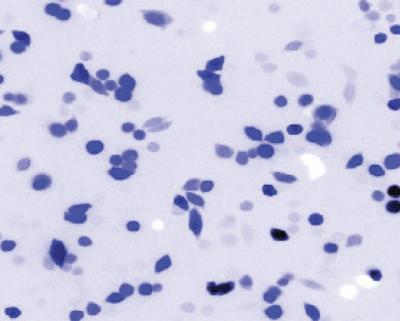A microfluidic system has been developed by researchers from JILA, a collaboration of the National Institute of Standards and Technology (NIST) and the University of Colorado Boulder (CU). The system tracks time in biochemical reactions in the range of milliseconds to seconds. Lasers were used for the measurement of sensor signals in the microfluidic system.
 Micrograph of human cells modified to act as metal sensors. Researchers at JILA built hardware to help time the dynamic states of these sensors, which change fluorescence color when they bind metal ions. The cells are false-colored to indicate the extent of their reactions; the darker cells have bound the most metal ions. Credit: Hairong Ma/JILA
Micrograph of human cells modified to act as metal sensors. Researchers at JILA built hardware to help time the dynamic states of these sensors, which change fluorescence color when they bind metal ions. The cells are false-colored to indicate the extent of their reactions; the darker cells have bound the most metal ions. Credit: Hairong Ma/JILA
Using these sensors, it is possible to collect the average FRET response value for about thousands of cells within minutes. In the FRET technique, light energy is absorbed from a laser by a large molecule and this energy is transferred to the next acceptor molecule. The energy is released as a fluorescent light by the acceptor molecule. The fluorescence is measured for the detection of the amount of energy transferred. Many cellular processes can be studied using FRET.
Research shows that the cell processes will be affected by the amount and type of metal ions present in the cells. JILA has used genetically modified cells for this study. The GM cells will absorb the metal ions and signal any change in concentration of metal ions by influencing the FRET signals.
In the study, a microfluidic device containing a flow control system was used. The chemicals with metal ions and the cells were mixed within milliseconds. The FRET fluorescence signal will be excited when the cell passes through two blue laser beams. The flexible design and accurate flow control of the device help in varying the travel time of the cell between the two positions from 1 ms to 10 s. The FRET signal changes within each cell between both the positions can be measured.
The study was done by Ralph Jimenez and team. The work was published in the Journal of the American Chemical Society.
Source: http://www.nist.gov